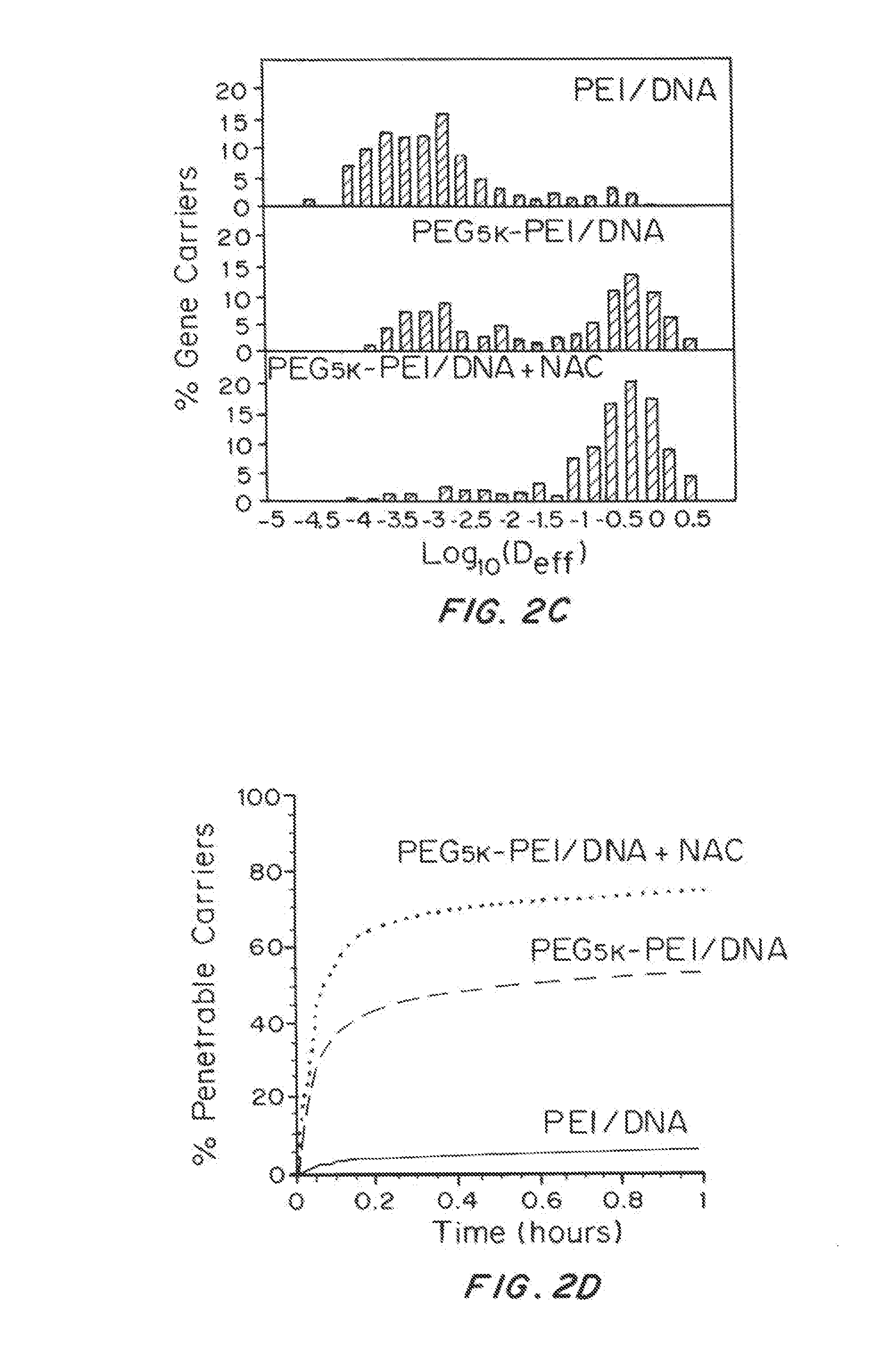Mucus Penetrating Gene Carriers
a gene carrier and mucus technology, applied in the field of gene delivery, can solve the problems of easy infection of the bronchial cavity of patients, abnormal transfer of chloride across the epithelial membrane of cf patients, etc., and achieve the effect of rapid and effective diffusion through mucus and preventing the complete digestion of cargo dna
- Summary
- Abstract
- Description
- Claims
- Application Information
AI Technical Summary
Benefits of technology
Problems solved by technology
Method used
Image
Examples
example 1
Formation and Characterization of Nanoparticle Gene Carriers
[0189]Materials and Methods
[0190]Conjugation of PEG to PEI
[0191]Methoxy PEG N-hydroxysuccinimide (mPEG-NHS, 5 kDa, Sigma Aldrich, St. Louis, Mo.) was conjugated to 25 kDa branched PEI (Sigma Aldrich) to yield PEG5k-PEI copolymer as follows. Briefly, PEI was dissolved in ultrapure distilled water and pH was adjusted to 7-8. Approximately 50 molar excess of mPEG-NHS was added to PEI solution and allowed to react overnight. After the reaction, the polymer solution was extensively dialyzed against ultrapure distilled water and then lyophilized. Nuclear magnetic resonance (NMR) was used to confirm a PEG:PEI ratio to be ˜37. The lyophilized polymers were dissolved in ultrapure distilled water and pH was adjusted to ˜7-7.5.
[0192]PEI-Based Gene Carrier Formulation
[0193]The plasmid pd1GL3-RL (7.9 kbp) containing two CMV-promoted luciferase genes were propagated in Escherichia coli DH5α (Kan / Neo selection). Plasmid DNA was collected ...
example 2
In Vitro and In Vivo Investigation of Nanoparticle Gene Carriers
[0207]Materials
[0208]CF Sputum Collection and Rheological Characterization
[0209]Sputum spontaneously expectorated from male and female CF patients (ages 24-37) was collected at the Johns Hopkins Adult Cystic Fibrosis Program. The procedures conformed to ethical standards of the Johns Hopkins Medicine Institutional Review Board. Samples were acquired from the weekly CF outpatient clinic, placed on ice upon collection and during transport, and studied the same day. The total number of individual samples used for the present studies was 4.
[0210]Treating CF Sputum with Mucolytic Agents
[0211]One molar solution of N-acetylcysteine (Sigma Aldrich) was prepared and adjusted to pH ˜7, since its mucolytic activity is optimal with a pH of 7.0-9.0. To study the effect of N-acetylcysteine (NAC) on the diffusion of nanoparticle gene carriers in CF sputum, sputum was treated with NAC (final concentration of 20 mM), for 30 min at 37° C...
PUM
| Property | Measurement | Unit |
|---|---|---|
| diameter | aaaaa | aaaaa |
| diameter | aaaaa | aaaaa |
| molecular weight | aaaaa | aaaaa |
Abstract
Description
Claims
Application Information
 Login to View More
Login to View More - R&D
- Intellectual Property
- Life Sciences
- Materials
- Tech Scout
- Unparalleled Data Quality
- Higher Quality Content
- 60% Fewer Hallucinations
Browse by: Latest US Patents, China's latest patents, Technical Efficacy Thesaurus, Application Domain, Technology Topic, Popular Technical Reports.
© 2025 PatSnap. All rights reserved.Legal|Privacy policy|Modern Slavery Act Transparency Statement|Sitemap|About US| Contact US: help@patsnap.com



